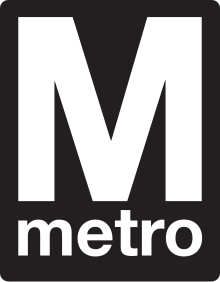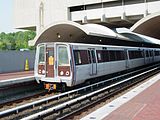Metro Washington
The Metrorail , or just Metro , is the subway system of the US capital Washington, DC and the adjacent Washington Metropolitan Area . With a line length of around 213.3 kilometers, the system is the second largest in the USA . It opened in 1976 and is operated by the Washington Metropolitan Area Transit Authority (WMATA).
history
The first planning began in 1960. Particular attention was paid to the efficiency of the subway and economical operation. This should be done, for example, by building the subway lines under public roads, but also numerous park-and-ride spaces and orientation to the bus system and the important traffic flows were part of it. The first contracts for the construction of the subway were approved by the American Congress on October 13, 1966 and signed a month later by the US President Lyndon B. Johnson . Construction work on the first Washington subway line began in 1969.
After seven years of construction, the first section of the Red Line between Farragut North and Rhode Island Avenue was opened on March 27, 1976 . This first route was 7.41 km long and had five stations. Since the Gallery Place station could not be completed by the time it opened, it was added on December 15 of the same year. Just one year later, an extension of the Red Line by one station to Dupont Circle went into operation. Due to constant construction, further lines could be opened in the next few years: On July 1, 1977 the Blue Line between National Airport and Stadium Armory ; the Orange Line on November 20, 1978 from Stadium Armory and New Carrollton; and on April 30, 1983, the Yellow Line from Pentagon to L'Enfant Plaza . The Green Line was the last line to go into operation on November 20, 1990. The American Society of Civil Engineers recognized the achievements of the construction project in 1979 with the Outstanding Civil Engineering Achievement Award .
Until September 11, 2001 , passengers could get directly from Pentagon station to the Department of Defense building; this exit was closed indefinitely after the terrorist attacks.
Because of its modern equipment and its architecturally sophisticated design, the metro originally enjoyed a very good reputation. Since the mid-1990s, however, problems with delays, train cancellations, ingress of groundwater and defective escalators have been increasing. In addition to insufficient maintenance, the causes include a lack of quality control and general mismanagement within WMATA. Difficulties are also caused by the fact that, unlike many other traffic authorities in the USA, WMATA does not receive any fixed allocations from the local tax pot and therefore does not have sufficient financial resources.
On June 22, 2009, two trains collided on the Red Line north of the city near Takoma Park station on the Maryland border, killing nine people and injuring more than 70. The accident happened when a train hit the stationary train waiting to enter the station (for details, see the track vacancy detection system ). Several cars pushed one another. As a result of the accident, Metro suspended automated driving on all lines. Since then, the trains have been accelerated and braked manually. Since April 13, 2015, 8 car trains have been running automatically on the Red Line again. Due to the necessary software updates, manual driving will remain for 6 car trains for the time being. The other lines should run automatically again by the end of 2017.
Before that, there was only one fatal accident. On January 13, 1982, three people died when a subway train derailed in a tunnel.
Line network
The network comprises six lines (the Silver Line will not be fully completed until 2018) with 91 stations and a line length of 213.3 kilometers. Every day around 700,000 passengers are transported with the subway, around 190 million throughout the year. The network has three transfer hubs in the city center, Metro Center , Gallery Place-Chinatown and L'Enfant Plaza , which make it possible to reach any destination with a single transfer.
The outer branches each extend several kilometers into the area of the neighboring states (Virginia and Maryland). Often stations here are conveniently located for car commuters and are equipped with large park-and-ride facilities. The metro runs Monday-Friday from 5:00 a.m. to 12:00 a.m., Saturdays and Sundays from 7:00 a.m. to 12:00 a.m.
Repeater trains run on the Red Line from Silver Spring to Grosvenor during rush hour. At the weekend every second train only runs to Silver Spring on this line. On the Orange Line , additional trains run from Vienna / Fairfax to Largo Town Center during rush hour. During rush hour, the Yellow Line trains run from Huntington to Mt. Vernon Square, as well as additional trains from Franconia-Springfield to Greenbelt. At other times, all trains on this line run from Huntington to Fort Totten. These adjustments to the route during rush hour are part of the Rush + capacity increase program .
The Blue Line will no longer stop at Arlington Cemetery from October 1st to April 1st from 7pm and from April 2nd to September 30th from 10pm .
Network expansion
A new line is currently under construction with the Silver Line . The first section to Wiehle-Reston East station was opened on July 26, 2014. The opening of the second section, which will extend the line to Dulles Airport , is expected in 2019 or 2020.
literature
- Deiter, Ronald H .: The story of Metro . Transportation and politics in the nation's capital. Interurban Press, Glendale (California) 1990, ISBN 0-916374-88-2 .
- Schrag, Zachary M .: The Great Society subway . A history of the Washington Metro. Johns Hopkins Univ. Press, Baltimore (Maryland) 2006, ISBN 0-8018-8246-X .
See also
Web links
Individual evidence
- ↑ Washington: Above hui, below ugh. (No longer available online.) Dpa, SÜDWEST PRESSE, October 26, 2010, formerly in the original ; Retrieved November 6, 2010 . ( Page no longer available , search in web archives ) Info: The link was automatically marked as defective. Please check the link according to the instructions and then remove this notice.
- ^ Layton, Lyndsey and Jo Becker: Efforts to Repair Aging System Compound Metro's Problems. The Washington Post, June 5, 2005, accessed November 6, 2010 .
- ↑ Tiroler Tageszeitung: U-Bahn accident in Washington: Two trains collided (accessed on June 22, 2009)
- ↑ CNN .com: Two killed in Washington-area subway train collision (English with video, accessed on June 23, 2009)
- ^ Metro to return Red Line to automatic train operation on Monday. (No longer available online.) WMATA, April 9, 2015, archived from the original on May 7, 2015 ; Retrieved April 30, 2015 . Info: The archive link was inserted automatically and has not yet been checked. Please check the original and archive link according to the instructions and then remove this notice.
- ↑ rush +: Rush Hour Reinvented. (No longer available online.) Washington Metropolitan Area Transit Authority, archived from the original on April 30, 2012 ; Retrieved May 17, 2013 . Info: The archive link was inserted automatically and has not yet been checked. Please check the original and archive link according to the instructions and then remove this notice.
- ↑ Metro launches Silver Line, largest expansion of region's rail system in more than two decades. (No longer available online.) WMATA, July 25, 2014, archived from the original on August 1, 2014 ; accessed on July 27, 2014 . Info: The archive link was inserted automatically and has not yet been checked. Please check the original and archive link according to the instructions and then remove this notice.






